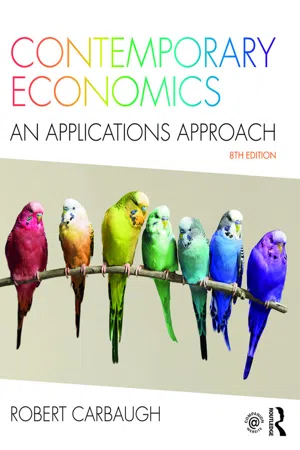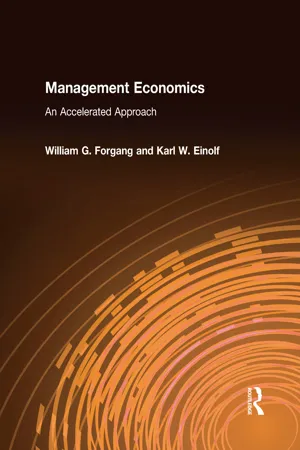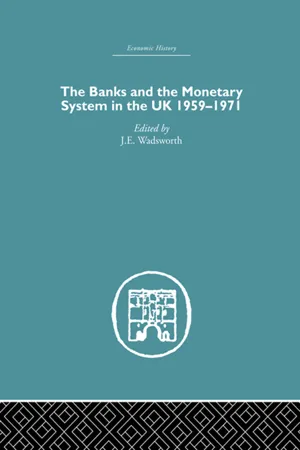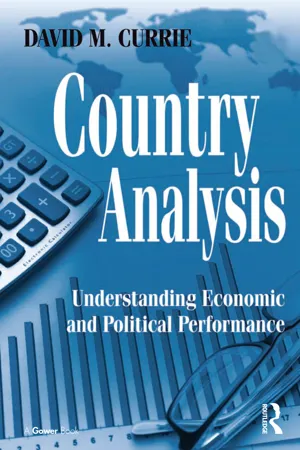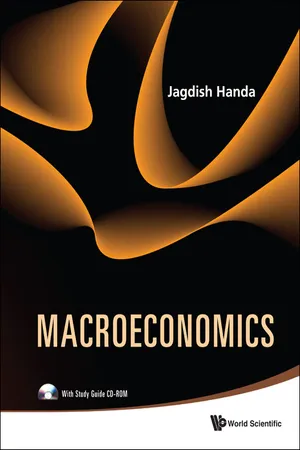Economics
Measures of Money Supply
Measures of money supply refer to the various ways in which economists quantify the amount of money in circulation within an economy. These measures typically include M0, M1, M2, and M3, each representing different components of the money supply such as physical currency, demand deposits, and savings deposits. These measures are important for understanding the overall liquidity and financial health of an economy.
Written by Perlego with AI-assistance
Related key terms
9 Key excerpts on "Measures of Money Supply"
- eBook - ePub
Trading Economics
A Guide to Economic Statistics for Practitioners and Students
- Trevor Williams, Victoria Turton(Authors)
- 2014(Publication Date)
- Wiley(Publisher)
Since the start of the 1980s, broad money velocity has trended downwards, reflecting the growing importance of financial intermediation in the economy. That trend might be expected to reassert itself at some point. But the experience of the 1990s would suggest that the trend could be interrupted for an extended period, if the forces pushing up on velocity are persistent enough. The recent conjuncture suggests that there are economic factors pushing up on velocity relative to its historical trend. These are likely to persist in the near term, suggesting that a given rate of growth in nominal spending is likely to be associated with weaker growth in broad money than was typically the case before the crisis.With consumer and business confidence low, as surveys repeatedly demonstrate, and debt levels high, households and businesses are not willing to increase debt by borrowing more. Having said that, although QE has not worked to aggressively raise the growth rate of money supply (though there has been some effect), there has been, on the plus side, a lower long-term interest rate and this must have helped to lower the rate of default for households and businesses, ensuring also that lenders have more funds to deal with issues of solvency.DECOMPOSITION OF MONEY
There are two ways of thinking about money supply – as the physical stock (instruments they are in) or the counterparts (the holders of the money).Physical Stock – Instruments They Are In
If you add up the entire stock of money, i.e. in current accounts, on deposit with banks, building societies and so on, it can be shown as Measures of Money Supply, as follows:- M0 – M0 is the narrowest definition of the quantity of money in circulation. The definition used in the UK is bank notes and coins in circulation, plus banks' deposits with the Bank of England and money in banks' tills. M0 is also known as the monetary base. This term refers to the fact that the money measured by M0 supplies the base on which other forms of money (such as bank deposits) are based.
- M1 – M1 is M0 plus saving accounts or sight deposits held by the private sector in banks and building societies in the UK. Sight deposits are sterling deposits that can be withdrawn on demand or that have been deposited overnight. It excludes non-sterling currencies.
- M2 – M2 is M1 plus retail deposits or savings accounts.
- M3 – M3 has been replaced by M4 in the UK as the main broad money measure. It is still, however, calculated as part of certain European aggregates. It consists of:
- notes and coins in circulation (defined as for M1 and M2);
- overnight deposits and sight deposits (as for M1);
- eBook - ePub
- W. Charles Sawyer, Richard L. Sprinkle(Authors)
- 2020(Publication Date)
- Routledge(Publisher)
monetary base (B). The monetary base (B) is composed of cash in the hands of thepublic (C) and the total quantity of bank reserves (R) on deposit at the central bank. In precise terms, the monetary base is:BOX 15.1WHAT IS THE SUPPLY OF MONEY?Even though the public can hold money for a variety of reasons, the supply of money that is relevant for the purposes of economic policy is a measure of money that will be used for economic transactions within a given period of time, such as a year. Unfortunately, in most countries such a perfect measure of the money supply does not exist. For example, in the U.S. neither M1 nor M2 is identical to the supply of money the public uses for short-run economic transactions. The primary reason why this is true is related to the existence of money market mutual funds. These funds can be used for transactions, as each account has limited check-writing capabilities. In addition, these accounts are also widely used as a parking place for funds between the purchase and sale of equities, bonds, and other long-term financial assets. As a result, M1 understates the amount of money that the public could use for short-run economic transactions, and M2 overstates this same amount. In this case, the central bank of the U.S. cannot know with certainty what the amount of money is that the public intends to use for short-run economic activities. To a greater or lesser extent, every country has this problem of defining what the relevant supply of money is. In the discussion that follows, we assume that there is a relevant supply of money under the central bank’s control. However, one should keep in mind that the supply of money in an economy is not as clear-cut in most cases as central bankers or those following the state of the economy might like.B = C + RA country’s money supply is equal to the monetary base multiplied by the banking money multiplier. The banking money multiplier is equal to 1 divided by the reserve requirement - No longer available |Learn more
Contemporary Economics
An Applications Approach
- Robert Carbaugh(Author)
- 2016(Publication Date)
- Routledge(Publisher)
However, defenders of the American penny maintain that its abolishment would result in problems. They fear that if the penny is eliminated, consumers would be hit with a rounding tax, since merchants would tend to round upward rather than downward. They also note that the penny aids causes in raising hundreds of millions of dollars each year for important charities like Ronald McDonald House Charities, School and Youth Programs, and the like. Moreover, the U.S. Mint’s fixed costs would continue to be incurred whether or not the mint produces the penny; these costs would be absorbed by the remaining denominations of circulating coins, without the penny adding to their production costs. Finally, if pennies were eliminated, Americans would switch to using the nickel which cost about 9 cents to manufacture in 2015. Would the government really be saving money by eliminating the penny?To date, the U.S. government has said that it needs more research before it can make a decision to either change the composition of the penny so as to include cheaper metals than zinc or copper or do away with the penny altogether.Sources: U.S. Mint, Annual Report, 2015; “Canada Drops Penny from its Currency,” Chicago Tribune, February 5, 2013; “Canadian Penny Discontinued,” The Huffington Post, February 4, 2013.Measuring the Money Supply: The M1 Money Supply
So far in this chapter, we have discussed many forms of money. Let us now consider how the money supply is measured in the United States.There are two approaches to defining and measuring money: the narrow definition of the money supply, which emphasizes the role of money as a medium of exchange, and the broader definitions of the money supply, which emphasize the role of money as a temporary store of value.Table 14.3 The M1 Measure of U.S. Money Supply, 2015Component In billions of dollars ($) Percent of Total Currency 1,309.0 43 Demand deposits 1,231.2 40 Other checkable deposits 506.6 17 Traveler’s checks 2.6 – Total 3,049.4 100 Source: Federal Reserve Board, Money Stock Measures, September 17, 2015, available at www.federalreserve.gov .Table 14.3 lists the components of the U.S. money supply according to its narrowest definition, the M1 money supply. This measure of the money supply includes currency in the hands of the public, demand deposits, other checkable deposits (NOW and share draft accounts), and traveler’s checks. M1 is expressed by the following formula:M1 = Currency in the hands of the public + Demand deposits + Other checkable deposits + Traveler’s checksIn our definition of money, we include currency only if it is in the hands of the public. - eBook - ePub
Management Economics: An Accelerated Approach
An Accelerated Approach
- William G. Forgang, Karl W. Einolf(Authors)
- 2015(Publication Date)
- Routledge(Publisher)
a medium of exchange. The unit of account function means that goods and services are priced in money terms. The medium of exchange function means that goods and services are exchanged for money.Application Box 3.6The nation’s money supply (M1) in November 2005 was $1,372 billion.Source: www.economagic.com.Therefore, one component of the money supply is currency and coins. However, many purchases are completed by writing checks, and dollar balances in checking accounts (demand deposits) are the largest part of the money supply. Checking deposits and currency and coin are the largest components of the M1 definition of money.The Equation of ExchangeOne way to examine the relationship between the money supply and gross domestic product is through the equation of exchange (see Table 3.1 ).The equation of exchange is an identity. On the left side of the equation, the supply of money (M ) is multiplied by the velocity of money (V ). The velocity of money is the average number of times a dollar or deposit is used to complete transactions during a year. For example, assume individuals are paid weekly and spend the full amount before their next pay period. Under these restrictive assumptions, the velocity of money is 52. If individuals are paid monthly and spend the full amount on goods and services prior to the next pay period, the velocity is 12.Table 3.1 Equation of ExchangeMV = PT Where: M = money supply V = velocity of money P = price level T = number of transactions The left side of the equation of exchange is total expenditures. It is the money supply multiplied by the velocity. The right side of the equation is total receipts , which are the average price of goods and services (P ) multiplied by the number of transactions (T - J.E. Wadsworth(Author)
- 2013(Publication Date)
- Routledge(Publisher)
In particular, let us add, money supply in Britain has to be considered in the environment of UK financial institutions, especially banks. If the money supply is important, it is presumably because of its relationship to aggregate demand. As the Radcliffe Committee put it, the ‘relevance of the availability of funds to the pressure of total demand is what lies behind the supreme importance which is often attached to “the supply of money”’. A clear distinction needs to be drawn between the stock of money and its flow, and until recently attention has been directed almost entirely at the effects of the flow. Today it is being increasingly suggested that attention should be paid to the stock, and in particular to changes in the stock.In discussing the money supply, however, a satisfactory definition is a first essential. In one sense an appropriate definition depends upon the context in which money supply is to be considered. If related to aggregate demand, the definition has to be concerned with the spendability of money. Thus it should be associated primarily with money in the sense of something that can be spent immediately, as contrasted with near-money, which is moderately liquid but cannot be used directly for spending by the holder. An example of near-money would be funds deposited with a building society or similar undertaking. Much near-money is readily spendable, though not normally directly or immediately as with currency and most bank deposits, but only after some other operation to turn it into one of those forms. Moroever, as we shall see, if it is turned into spendable money it does not increase the total of final means of payment – that is to say, the ‘active’ money supply.In International Financial Statistics , published by the International Monetary Fund, money is by implication defined as currency and bank deposits, the figures for the United Kingdom including balances on deposit as well as current accounts. ‘Quasi-money’ – that is, near-money – is defined generally as ‘time and savings deposits and other liabilities of the monetary system that the user of the data may or may not wish to consider to be money’. Thus it is clearly indicated that any definition of the money supply is subjective, and depends upon the attitudes of users and their intentions. The figures recorded in International Financial Statistics are quite close to those given by the Central Statistical Office in its publication Financial Statistics . This, too, admits that ‘any definition of the money supply is arbitrary’. The Organisation for Economic Cooperation and Development, by implication, has accepted this point, as it was until recently publishing a series for the United Kingdom on a very narrow basis, but has now changed to one based on the Financial Statistics series. This widely accepted definition combines currency in circulation with the public with net deposits by UK residents with the whole of the banking sector,13 including both sterling and non-sterling current and deposit accounts. Table A8- eBook - ePub
Country Analysis
Understanding Economic and Political Performance
- David M. Currie(Author)
- 2016(Publication Date)
- Routledge(Publisher)
Because growth of the money supply contributes to inflation, the temptation is to look simply at yearly changes in the money supply. However, one could get the wrong impression by focusing solely on money supply growth because a growing economy needs to have a growing money supply. Therefore, a better measure is to compare growth of the money supply to growth of the economy. If the money supply is growing faster than the economy, there will be pressure for prices to increase. If the money supply is growing slower than the economy, it could retard economic growth.Which measure of economic growth is appropriate? Our old friend real GDP is a viable candidate because it measures the output of goods and services produced in the economy. Table 6.2 shows growth rates of each indicator for the US from 2000 to 2006. As you see, the money supply grew faster than did real GDP during the period, so we expect moderate inflation in the US.Developing a relationship between growth rates of real GDP and the money supply is filled with statistical issues, so the table is simply a demonstration. One issue is which measure of the money supply to use: M1, M2, or perhaps another that we haven’t discussed. The Fed performs studies about which money supply indicator correlates better with price changes, and M2 appears to be most appropriate in the US. Another issue is the time lag between when a change in the money supply has an effect on either prices or the output of goods and services. Evidence indicates that the economy begins to slow about six months after the Fed tightens monetary conditions, and inflation starts to slow after about a year has passed. A third issue is that money supply data is collected monthly but GDP data is collected quarterly, so it is necessary to adjust for the difference. In other words, deriving a simple statistical relationship isn’t nearly as easy as it sounds.Table 6.2 Comparison of growth rates of money supply to real GDPConclusion
Money performs important functions in an economy, and it is tempting to think that the solution to many problems is simply to inject more money into the economy. Unfortunately, it is not that easy. More money frequently leads to higher inflation, which is not popular with global investors and violates one of the principles of the Washington Consensus. - eBook - ePub
Macroeconomics
(With Study Guide CD-ROM)
- Jagdish Handa(Author)
- 2010(Publication Date)
- WSPC(Publisher)
near-banks — i.e., those financial institutions in which the deposits perform almost the same role for depositors as similar deposits in commercial banks. Examples of such institutions are savings and loan associations and mutual savings banks in the United States (USA); credit unions, trust companies, and mortgage loan companies in Canada; and building societies in the United Kingdom (UK). The incorporation of such deposits into the measurement of money is designated by the symbols M3, M4, etc., or by M2A (or M2+), M2B (or M2++), etc. However, the definitions of these symbols have not become standardised, so that their definitions remain country specific.Financial institutions in the economyFinancial institutions are firms involved in the process that determines the money supply and interest rates. They also intermediate between the borrowing and lending processes in the economy. In practical terms, financial institutions include the central bank, commercial banks, near-banks such as credit unions, trust companies, brokerage companies, postal banks, pension funds, etc. They do not engage in the production or consumption of commodities but receive funds from some sources and channel them to others (i.e., invests them).2.2 Money Supply and Money StockMoney is a good, which, just like other goods, is demanded and supplied by the various participants in the economy. There are a number of determinants of the demand and supply of money. The most important of the determinants of money demand are national income, the price level, and interest rates, while that of the money supply is the behavior of the central bank of the country which is given the power to control the money supply and bring about changes in it.The equilibrium amount in the market for money specifies the money stock , as opposed to the money supply , which is a behavioral function. These are depicted in Figure 2.1a with the nominal quantity of money M on the horizontal axis and the market interest rate r on the vertical axis. The money supply curve is designated as M s and the money demand curve is designated as M d . The equilibrium quantity of money is . It equals the quantity of money supplied at the equilibrium interest rate . Note that the quantity is strictly speaking not the money supply, which has a curve or a function rather than a single value. However, is the money stock that would be observed in equilibrium.1 - Merijn Knibbe(Author)
- 2019(Publication Date)
- Routledge(Publisher)
These estimates are connected to the national accounts (which use the same economic sectors) using what can veritably be called ‘the macroeconomic formula of everything’. To show this, we will discuss the monthly monetary press release of the ECB. In this release, it distinguishes three kinds of money (M1, M2 and M3) which consist of eight subcategories of money as spelled out in Table 3.3. About the subcategories it states that they are: Monetary liabilities of MFIs and central government (post office, treasury) vis-à-vis non-MFI euro area residents excluding central government. In August 2012, the ECB has amended its statistical measurement of broad money to adjust for repurchase agreement (repo) transactions with central counterparties. The quote shows that the ECB operationalization of money changes when the facts change. And a ‘repurchase agreement’ is a tradeable financial pawn agreement which pawns financial assets instead of consumer durables. This ECB operationalization of ‘money in circulation’ leaves us in the dark about what happened to ‘Deposits with an agreed maturity of more than 2 years’ (longer term saving deposits or more or less Keynes’ ‘savings money’). Loans create deposits, but not all these deposits are included in the M3 monetary aggregate. These long-term deposits are not considered to be part of ‘money in circulation’ as, conceptually, the distinguishing aspect of money is according to the ECB the ability to use it as a means of exchange at short notice and against little cost (ECB 2012a), which is generally not true for longer term save deposits. These long-term deposits are however created in the same way as ‘M3’ deposits: ‘loans create deposits and some of these may be channeled to long-term saving accounts’. Anyway – they are on the balance sheet of MFIs as well as households and non-financial companies- eBook - ePub
- Anthony J. Makin(Author)
- 2016(Publication Date)
- Routledge(Publisher)
2 International monetary measuresStatisticians have been refining measures of economy-wide performance since Sir William Petty began this for England in the mid-1600s. What has evolved is an elaborate system of monetary and real-sector accounts that national statistical authorities are responsible for publishing, according to internationally agreed conventions, in an objective and reliable way.To evaluate the behaviour of open economies it is necessary to understand the concepts, definitions and measurement of the main monetary variables. This chapter aims to do this by explaining the main conceptual linkages between these variables, on which the theory of later chapters depends.In addition to the basic national income measures, an open economy’s performance is also gauged with reference to movements in key financial variables, most notably interest rates and exchange rates, as well as the balance of payments or external accounts.What follows focuses on the flows of expenditure, production, income, investment and saving. A flow is a measure of some quantity per period of time, such as per quarter (3 months) or per financial year (say from 1 July to 30 June). These aggregates are, by dimension, quantities or volumes. Not all the quantity variables of monetary economics are flows, however. Other quantity magnitudes are stocks measured at a point in time, such as at the end of the financial year. Flow changes usually imply corresponding changes in stock values.For instance, investment as a flow increases the capital stock, the budget deficit as a flow increases the stock of public debt, and the current account deficit as a flow increases the stock of foreign debt.This chapter also examines macroeconomic variables, which are, by dimension, prices. Such measures include the overall price level itself, which conveys, in a single number, movements in millions of individual goods and services prices throughout the economy. The other key economy-wide prices are the exchange rate and the interest rate, which are determined on the monetary side of the economy.
Index pages curate the most relevant extracts from our library of academic textbooks. They’ve been created using an in-house natural language model (NLM), each adding context and meaning to key research topics.


